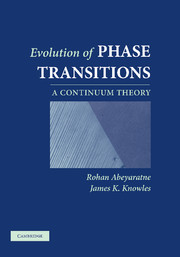Book contents
- Frontmatter
- Contents
- Preface
- Part I Introduction
- Part II Purely Mechanical Theory
- Part III Thermomechanical Theory
- 5 Multiple-Well Free Energy Potentials
- 6 The Continuum Theory of Driving Force
- 7 Thermoelastic Materials
- 8 Kinetics and Nucleation
- Part IV One-Dimensional Thermoelastic Theory and Problems
- Part V Higher Dimensional Problems
- Author Index
- Subject Index
8 - Kinetics and Nucleation
Published online by Cambridge University Press: 12 August 2009
- Frontmatter
- Contents
- Preface
- Part I Introduction
- Part II Purely Mechanical Theory
- Part III Thermomechanical Theory
- 5 Multiple-Well Free Energy Potentials
- 6 The Continuum Theory of Driving Force
- 7 Thermoelastic Materials
- 8 Kinetics and Nucleation
- Part IV One-Dimensional Thermoelastic Theory and Problems
- Part V Higher Dimensional Problems
- Author Index
- Subject Index
Summary
Introduction
In Chapters 3 and 4 we used particular one-dimensional initial–boundary value problems to demonstrate that, because of a massive lack of uniqueness that exists otherwise, elasticity theory must be supplemented with a kinetic law and nucleation condition if it is to be used to model the emergence and evolution of multiphase configurations. As shown there, not only is there a need for such information, there is also room for it in the theory. A second motivation for a kinetic law, also presented in Chapter 3, arose by casting the quasistatic problem considered there in the framework of standard internal-variable theory; the evolution law characterizing the rate of change of the internal variable in that theory is then the kinetic law.
In the present chapter we provide a third approach to the notion of kinetics, this one from a thermodynamic point of view. In addition to providing a motivation, the discussion here allows us to describe the kinetic law within a general three-dimensional thermoelastic setting.
In Section 8.2 we present the thermodynamic formalism of irreversible processes in a thermoelastic body. Based on this, we introduce the notion of a thermodynamic driving force and the flux conjugate to it, and the notion of a kinetic relation then follows naturally. In Section 8.3 we present some phenomenological examples of kinetic relations, while in Section 8.4 we describe examples of kinetic relations based on various underlying transformation mechanisms. Some remarks on the nucleation condition are made in Section 8.5.
- Type
- Chapter
- Information
- Evolution of Phase TransitionsA Continuum Theory, pp. 124 - 146Publisher: Cambridge University PressPrint publication year: 2006



